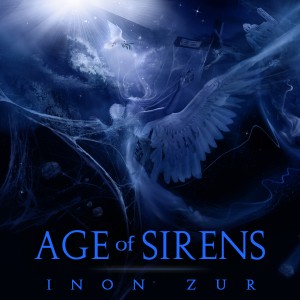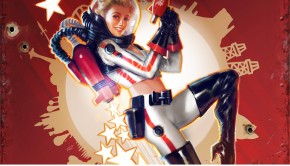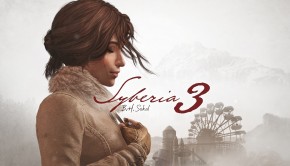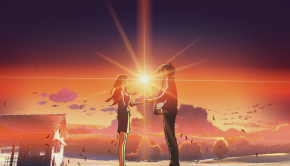Age of Sirens
 |
Album Title: Age of Sirens |
| Record Label: Self-Published |
|
| Catalog No.: N/A |
|
| Release Date: July 31, 2015 |
|
| Purchase: Purchase at iTunes |
Overview
Inon Zur has been a rising force in the game music world in the past decade, scoring for big names like Dragon Age, Prince of Persia, and Fallout. His recent release, “Age of Sirens,” is a independent compilation album of unreleased tracks taken from and inspired by previous works. The album is eclectic and whimsical, and sprawls across a plethora of genres from beginning to end, and brings in artists such as Aeralie Brighton, Aubrey Ashburn, and the Lyris Quartet to maximize the range of sounds produced in the album. However, Zur also incorporates a consistent pattern of solo and ensemble talents supporting a constant Zur-eque tone that even a first-time listener of Zur’s work would almost certainly recognize by the end.
Body
I will be the first to admit that I am not as familiar with Zur’s work as others may be, although what I have come across I have deeply enjoyed. Zur has stated that he meant this album to be for fans of his music, as the album includes pieces of themes originally written for other works that we may recognize. I have not followed his music closely enough to be able to identify the original sources for any of these tracks, although if Zur also means for this album to attract new fans – in addition to giving something back to older followers – this album is almost certainly successful (moreover, I would be heavily interested in knowing where a few of my favorite tracks came from, as I would very much like to hear continuations of these). I was hypnotized by many of the tracks, and became rather familiar with a feeling of disappointment that accompanied the end of any track, as the same themes rarely showed up again, given the kaleidoscopic nature of the album, which takes strands of various melodies, genres, styles and weaves them into eighteen compact pieces in Age of Sirens.
The opening of the album gives a kind of preview to the rest of the tracks, but by no means encompasses everything that will be featured on the album. “Prelude” opens the track with a string quartet alongside piano and drums – the quartet is not the start of this opening, but works together with the other instruments to create a kind of nouveau sound. The piece quickly crescendos before fading away, and gives way to the following piece, “Long Time Ago,” which features singer Aeralie Brighton, known for her vocal contributions to Ori and the Blind Forest. This piece picks up with a far more distinct melody line than “Prelude,” very carefully asked, answered, varied, transposed, and so on as the piece makes its way towards its finish. “Alone,” offered as an early purchase before the album was released, has a far more minimalist feel, featuring the vocal talents of Ashley Ashburn (Dragon Age: Origins) against a piano so soft that it doesn’t do much other than add some very mild harmonies, and allows Ashburn to maintain a solo sound in her part. Other instruments pick up the part as Ashburns’s voice fades, becoming one of the instruments before vanishing, and rise higher and higher on the scale, pausing on a dissonant chord, and finally resolving.
“Streets of Rome” was the first song from the album that I favorited on iTunes. It has a folklore feel in its primary instrumentation, but supplementary instruments adding to the melody that bring it to a more ethereal level. In fact, I think “ethereal” is the best way to describe this album – Zur does not use genres to restrict his compositions, but to direct them, before adding in other components far outside of that genre to give an added sense of otherworldliness to his pieces. The risk in this approach is that the different genres will then blend together through the added instrumentation, but enough pieces stand out brightly to ensure that this approach is successful. “Where Else” brings a completely new style to the album again, introducing an rhythm that is at times intricate and at times as simple as the emphasis of the four beats of a common time measure. The piece sounds strangely mechanical, which separates it significantly from the other tracks on the album.
Later on in the album, “Sacred” introduces a new melody in an electric setting, with synthesized and electric guitar notes being plucked out heavily from a background of mottled choir and strings. There is no question that the guitar here is the star, and despite the piece’s almost ambient nature, the guitar maintains a definite melody. It reminds me of one of the older Shin Megami Tensei games, particularly at the piece’s beginning, but perhaps with more color splashed in. As the piece continues, the strings take more of a definitive form, and the choir picks up some notes that are discernibly in harmony with the rest of the piece. “Remembrance” features the Lyris String Quartet, and once again showcases Zur’s ability to work in a medium different from the rest of the album. Yes, the opening “Prelude” also utilized the same string quartet, but in a more avant-garde way, and without the focus on the string quartet that “Remember” has, which feels more like a string quartet piece than a piece that happens to be incorporating a string quartet. A piano echoes the melody and some of the harmonies, but the strings remain firmly at the forefront of the piece, rippling through a sorrowful descending melody right up until the end.
“Way to Eternity” is a breathtaking choir piece, opening with a string rhythm suspiciously similar to “What Else,” but very clearly going in its own direction after a few measures have passed, as other instruments begin to subdivide the rhythm into indiscernible melodies. When the choir eventually comes in, it overpowers the other instruments with its own melody, and seems to pick up the pace of the track, bringing in choir before the end. “Going East” opens with an eerie melody, first on higher flutes and then lower trombones, the latter continuing on to complete the melody. The resulting piece is fiercely proud, even patriotic, and the delicate chord progressions that Zur begins to build into the melody as it continues give the piece an added dimension and edge in the album. This is easily one of the pieces I would love to see in a more extended form.
I found myself enjoying pieces in clusters rather than individual tracks, perhaps as a result of the track lengths, or perhaps just because some of the pieces flow really well into each other. Regardless, I thought that the score ended on an extremely high note. “We Were Soldiers” begins the ending streak with a heavily electric vibe, not unlike “Sacred” but with far more emphasis on the electronics, and less acknowledgement of any other instruments. The overall structure of the piece is a straightforward upwards scale, but each note upwards introduces a new chord, and increases the power of the rest of the instruments. It reminded me of an exercise I’ve learned from theory and composition professors in which the student can only take one note, or one sequence of notes, and create a piece out of those notes alone. As a big proponent of composers taking a small amount of material and doing a lot with it, I thoroughly enjoyed this track, and was for once content with its length.
I’m not sure I would have enjoyed “True Life” as much on any other album, as it teeters into syrupy territory at times, but I found it very welcome on this album. It was somehow refreshing to have a piece that didn’t subscribe to the ethereal nature of the rest of the album, and served as a delicate pause before the final track, or a conclusion to the album before its epilogue (or, “Epilogue,” as the case may be). Not exactly a piece I would frequently select on its own, but a welcome one in a mix of darker or more experimental tracks. The final track, “Epilogue,” opens with an eerie, almost atonal set of notes that soon resolves itself into a key that is picked up by a fuller orchestra. The piece never quite picks up in pace, but the increased intensity of it from beginning to end gives it a swell shape that fits its melancholy-but-hopeful melody well.
Summary
My one complaint about the album is the lengths of tracks. It’s an issue I can understand, given the album’s eclectic origin, but I deeply enjoyed these pieces, and found myself wanting more of them. While I suspect more long-time fans of Zur’s will recognize the origins of several of these pieces, I will be on the other side, pursuing more of his past work to find those origins. Age of Sirens is a fantastic listen for fans of Zur as well as fans of any contemporary or New Age orchestral endeavors.
Do you agree with the review and score? Let us know in the comments below!
4.5
Posted on August 6, 2015 by Emily McMillan. Last modified on August 8, 2015.














